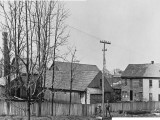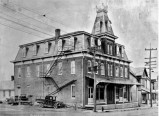NOTICE
The following is an article found by Ms. Babette Greenwood in the Macungie Web Site.
AUTHOR
William Mickley Weaver
1889
As the tanning business declined during the late nineteenth
century, other uses were sought for the property.
Early in 1889, Joel Kelchner of Fleetwood began negotiations
with James Singmaster to build a new creamery
next to his tannery, utilizing the tannery’s steam power
to run the centrifugal creamery machines. The creamery
opened for business in early January 1890, and continued
to serve the Macungie community under various
ownerships until finally closing around 1918.
During the twentieth century, this property was
the site of automobile garages owned and operated by
William Acker, and later by Norman Butz; old-timers
remembered undertaker Levi Funk housing his horse-
drawn hearse in one of the old tannery outbuildings. In
February of 1959, while excavating for the foundation
of a new Macungie Post Office building, irregular stone
walls were uncovered that were once part of the huge
curing vats that occupied the site.
Today, the property is split into several smaller parcels,
including the Bear Swamp Diner and Master Supply
Line.
Singmaster Hall
174 East Main Street
(1889)
PHOTOGRAPHS
| To view one of the photos, click on it and, when finished, click BACK |

Before the Re-Build
|

Bulding in use
|
This extremely interesting three-story brick building was
erected by James Singmaster during the summer and fall
of 1889. As O. P. Knauss writes in the December 26, 1889,
issue of the Macungie Progress:
It is the most imposing business structure in town
and an ornament that our citizens can be proud of.
The first floor is divided into two splendid rooms,
both with entire open fronts and ample side light
from numerous windows. The ceilings and wainscoting
are of the finest pine and the woodwork is
neat and appropriate. On the second floor are also
two rooms suitable for stock-room or manufacturing
purposes. In the eastern a brick hearth has been
erected for the use of tailors. The third floor is a
hall for public assemblies or society purposes, two
ante-rooms being at the back part. … A French roof
crowns the building, surmounted at the front by a
turret sixteen feet high. Windows on the three sides
of this turret furnish a splendid view over the surrounding
country. The top is ornamented with an
iron railing and point.
The firm of R. J. Ritter, Kutztown, was the first business
venture to lease space in the new building, occupying
both the eastern first and second floors for their Furniture
and House furnishing Goods business.
The third
floor hall hosted social events, including church dinners,
dances, motion picture viewings, lodge meetings, and
musical performances.
The building remained in Singmaster/Weaver family
ownership for two more generations, until Edna Weaver
Linton, granddaughter of James Singmaster, sold the
property on February 1, 1947, to Clarence M. J. Butz, Eva
V. Butz, and Norman M. Butz, who operated it as the
Butz Garage. After the death of Clarence and Eva Butz,
the property was sold by Norman M. Butz to his brotherin-
law and sister, Francis and Evelyn Jacob, in 1959. Over
the past 120 years, this building has also been the site of
J. F. Wieder paper box manufacturing, the Horwith Knitting
Mill, Main Street Floral, and IMPCO, to name a few.
Today, the first floor of the building
is the home of Salvatore’s Pizzeria,
with the Larry Jacob Auto Repair
shop occupying the rear frame
section. The second and third floors
are now divided into apartments.
Architectural Comments
Except for Solomon’s Church, Singmaster
Hall is the most dominant building,
by size, on this Singmaster tour. It might
be considered the last great bastion of a
quasi-public building within the borough
that signifies the great changes
that occurred from the beginning of the
nineteenth century, when the area was
still almost exclusively a back-roads
farming community, to the ushering in
of modernism at the start of the twentieth
century. Today, it provides a place of
Walter Greisamer, East Greenville,
circa 1918
wonder about what people experienced
more than 125 years ago.
Its dimensions are 50½ feet on the Main Street side, by
60 feet deep along Poplar Street. Few other buildings in the
borough compare to it in square footage, and despite extensive
alterations on its front wall, the building is unmistakably of
Second Empire style. These buildings were erected in the 1855
to 1885 era; just one other building in the borough is of this
architectural style.
The dead giveaway for the Second Empire style designation
is the mansard, or dual-pitched, roof. It is named for the seventeenth
century French architect François Mansarde (1598–1666).
A feature most often associated with this architectural type is the
decorative brackets, or Italianates, beneath the eaves. Nine such
wood elements are seen across the top of the second floor of the
front wall. They are also found elsewhere on the building.
The structure is two stories in height, plus the third-floor
level that includes the distinctive and defining roof area. The
entire façade has experienced a face lift in the last several decades,
where a modern brick-coat was affixed to the exterior
wall surface. The first floor on the front has also been greatly
altered as accommodations for new businesses.
Three sections define the second floor on the front wall.
Each side section has three windows with arched bricked tops,
and the middle section has two narrow windows with the same
arched tops. On the mansard roof, two 2-over-2 windows appear
at each side, with V-sloped wood trim at their tops. At the
middle are two windows with arched, bricked tops.
Rising high above the third floor level is a prominent, almost
overpowering, middle-section tower. It has a looming presence,
and some onlookers may sense almost spooky-like feelings that
emanate from its position of dominance, even stark aloneness.
Its roof is covered with the slate that was the original covering.
Windows are on three sides but not the rear of the tower.
The northwest side of the building remains the best-preserved
exterior wall. This full wall has its original exposed
bricks. Every eighth course or so is composed of “headers.” All
the rest are “stretchers.” An exposed stone foundation wall can
also be seen. Six Italianate brackets are at the top of the second
floor. Six 2-over-2 windows occupy this floor level, and each
window has triple-level arched brick lintels. The mansard roof
has five 2-over-2 windows, and the roof is covered with slate.
The three windows on the first-floor level also have the triple
layer of bricks in arched form. Interestingly, the middle layer
is in a saw-tooth form that is at distinct odds with the flat, recessed
middle layer of bricks on the second-floor level windows.
The entire southeast wall was finished with modern brick-
coat identical to the brick on the front wall. A legitimate question
is — why the difference? The southeast wall is far more visible
than the opposite wall. When the building was modernized, the
building owner, probably because of cost constraints, limited his
updating of the building to the two most easily seen walls — the
front and the southeast. Three windows are seen on the first
floor, while five windows and one door are seen on the second
floor. Six Italianate brackets adorn the eaves at the top of the second
floor. On the mansard roof, five 2-over-2 windows are seen,
identical to the roof on the northwest wall. On the first floor a
large modern door opening is located near the rear corner.
Like the northwest wall, original brick is exposed on the
rear wall, not often seen by passersby. No brackets appear on
this wall. At the mansard roof level are four 2-over-2 windows.
Wide boards appear as fascia at the top of the second floor, and
are also seen on the three other walls. A one-story frame wing,
likely non-original, covers a great deal of the rear wall.
Click here to return
� sport blue 3s sport blue 3s Sport blue 14s Oakley Sunglasses wolf grey 3s louis vuitton uk michael kors outlet louis vuitton outlet kate spade outlet kate spade outlet cheap air jordans louis vuitton outlet Lebron 11 coach factory outlet lebron 12 cheap jordans louis vuitton outlet michael kors uk wolf grey 3s Louis Vuitton Outlet


